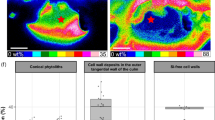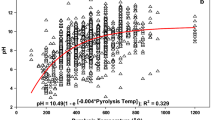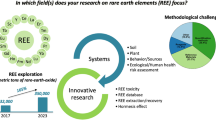Abstract
Soil organic matter (SOM) is involved in many important ecosystem processes. Ultrahigh resolution mass spectrometry has become a powerful technique in the chemical characterization of SOM, allowing assignment of elemental formulae for thousands of peaks resolved in a typical mass spectrum. We investigated how the addition of N, S, and P heteroatoms in the formula calculation stage of the mass spectra processing workflow affected the formula assignments of mass spectra peaks. Dissolved organic matter extracted from plant biomass and soil as well as the soil humic acid fraction was studied. We show that the addition of S and P into the molecular formula calculation increased peak assignments on average by 17.3 % and 10.7 %, respectively, over the assignments based on the CHON elements frequently reported by SOM researchers using ultrahigh resolution mass spectrometry. The organic matter chemical characteristics as represented by van Krevelen diagrams were appreciably affected by differences in the heteroatom pre-selection for the three organic matter samples investigated, especially so for the wheat-derived dissolved organic matter. These results show that inclusion of both S and P heteroatoms into the formula calculation step, which is not routinely done, is important to obtain a more chemically complete interpretation of the ultrahigh resolution mass spectra of SOM.



Similar content being viewed by others
References
Nebbioso A, Piccolo A (2013) Molecular characterization of dissolved organic matter (DOM): a critical review. Anal Bioanal Chem 405:109–124
Kögel-Knabner I (2002) A review on the macromolecular organic composition in plant and microbial residues as input to soil. Soil Biol Biochem 34:139–162
Kleber M, Johnson MG (2010) Advances in understanding the molecular structure of soil organic matter: implications for interactions in the environment. Adv Agron 106:77–142
Piccolo A (2001) The supramolecular structure of humic substances. Soil Sci 166:810–832
Nebbioso A, Piccolo A (2011) Basis of a humeomics science: chemical fractionation and molecular characterization of humic biosuprastructures. Macromolecules 12:1187–1199
Bolan NS, Adriano DC, Kunhikrishnan A, James T, McDowell R, Senesi N (2011) Dissolved organic matter: biogeochemistry, dynamics, and environmental significance in soils. Adv Agron 110:1–75
Sleighter RL, Hatcher PG (2007) The application of electrospray ionization coupled to ultrahigh resolution mass spectrometry for the molecular characterization of natural organic matter. J Mass Spectrom 42:559–574
Bleam WF (2012) Soil and environmental chemistry. Academic, New York
He Z, Ohno T, Cade-Menum B, Erich MS, Honeycutt CW (2006) Spectral and chemical characterization of phosphates associated with humic substances. Soil Sci Soc Am J 70:1731–1751
Stubbins A, Spencer RGM, Chen H, Hatcher PG, Mopper K, Hernes PJ, Mwamba VL, Mangangu AM, Wabakanghanzi JN, Six J (2010) Illuminated darkness: molecular signatures of Congo River dissolved organic matter and its photochemical alteration as revealed by ultrahigh precision mass spectrometry. Limnol Oceanogr 55(1467-1):477
Kendrick E (1963) A mass scale based on CH2 = 14.0000 for high resolution mass spectrometry of organic compounds. Anal Chem 35:2146–2154
Hughey CA, Hendrickson CL, Rodgers RP, Marshall AG, Qian K (2001) Kendrick mass defect spectrum: a compact visual analysis for ultrahigh-resolution broadband mass spectra. Anal Chem 73:4676–4681
Kujawinski EB, Longnecker K, Blough NV, Del Vecchio R, Finlay L, Kitner JB, Giovannoni SJ (2009) Identification of possible source markers in marine dissolved organic matter using ultrahigh resolution mass spectrometry. Geochim Cosmochim Acta 73:4384–4399
Hockaday WC, Purcell JM, Marshal AG, Baldock JA, Hatcher PG (2009) Electrospray and photoionization mass spectrometry for the characterization of organic matter in natural waters: a qualitative assessment. Limnol Oceanogr-Meth 7:81–95
Stott DE, Martin JP (1990) Synthesis and degradation of natural and synthetic humic material in soils. In: MacCarthy P (ed) Humic substances in soil and crop sciences: selected readings. Soil Science Society of America, Madison, pp 37–63
Stevenson FJ (1994) Humus chemistry: genesis, composition, reactions. Wiley, New York
Kemmer G, Keller S (2010) Nonlinear least-square data fitting in Excel spreadsheets. Nat Protoc 5:267–281
Trembay LB, Dittmar T, Marshall AG, Cooper WJ, Cooper WT (2007) Molecular characterization of dissolved organic matter in a North Brazilian mangrove porewater and mangrove-fringed estuaries by ultrahigh resolution Fourier transform-ion cyclotron resonance mass spectrometry and excitation/emission spectroscopy. Mar Chem 105:15–29
Ohno T, Chorover J, Omoike A, Hunt J (2007) Molecular weight and humification index as predictors of adsorption of plant- and manure-derived dissolved organic matter to goethite. Eur J Soil Sci 58:125–132
Acknowledgments
This project was supported by USDA–National Research Initiative Competitive Grant no. 2008-35107-04480 from the USDA Cooperative State Research, Education, and Extension Service, and NSF DEB-1056692. It has also been supported by Hatch funds provided by the Maine Agricultural and Forest Experiment Station. We thank Dr. Rachel Sleighter of Old Dominion University for providing the MATLAB script which is used to constrain the formula list to chemically feasible formulae and for discussion of mass spectra processing. We also thank the anonymous reviewers for valuable comments and suggestions which significantly improved this manuscript. This is Maine Agricultural and Forest Experiment Station Journal no. 3304.
Author information
Authors and Affiliations
Corresponding author
Rights and permissions
About this article
Cite this article
Ohno, T., Ohno, P.E. Influence of heteroatom pre-selection on the molecular formula assignment of soil organic matter components determined by ultrahigh resolution mass spectrometry. Anal Bioanal Chem 405, 3299–3306 (2013). https://doi.org/10.1007/s00216-013-6734-3
Received:
Revised:
Accepted:
Published:
Issue Date:
DOI: https://doi.org/10.1007/s00216-013-6734-3




